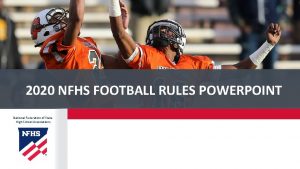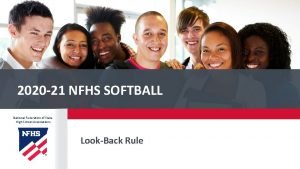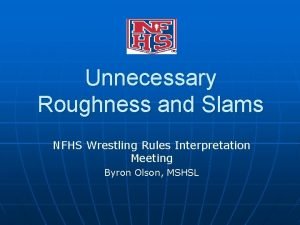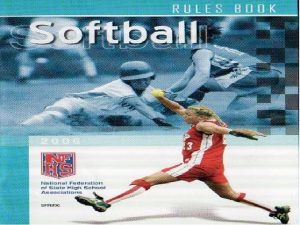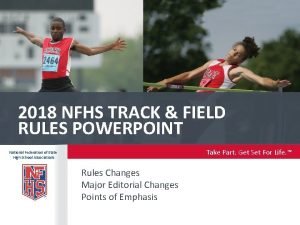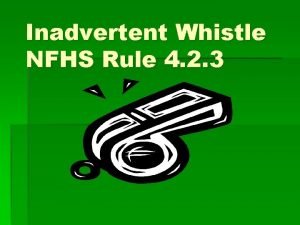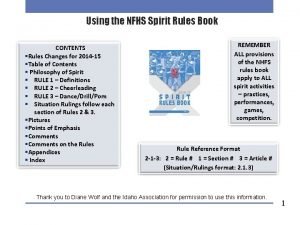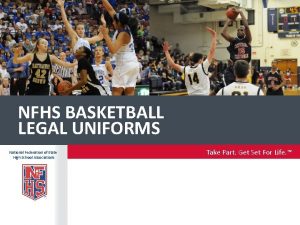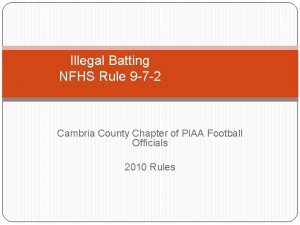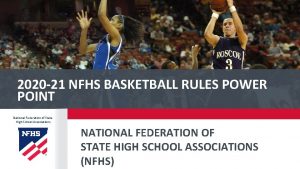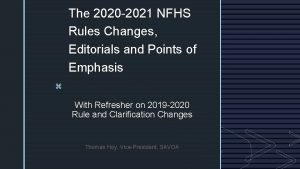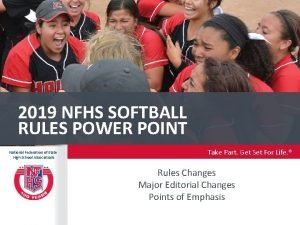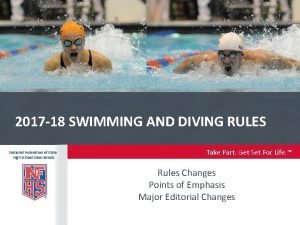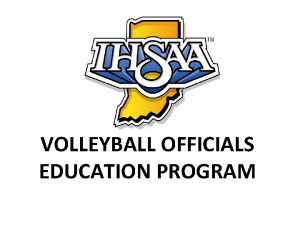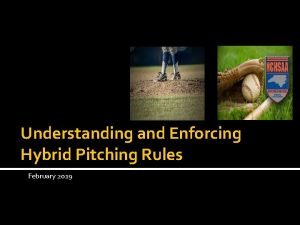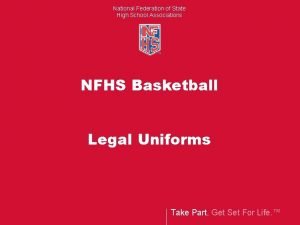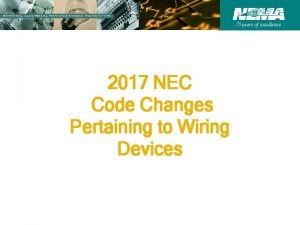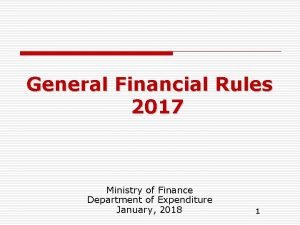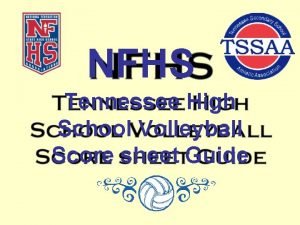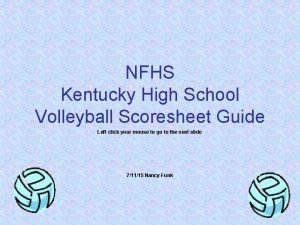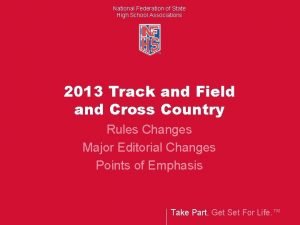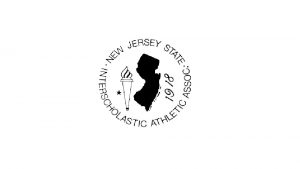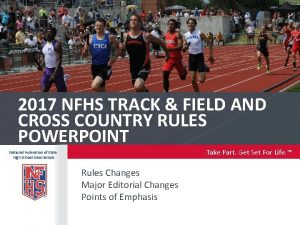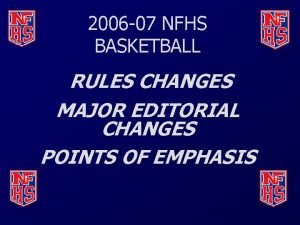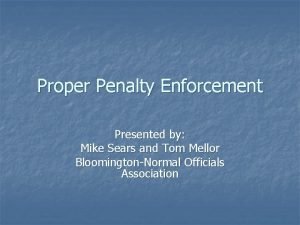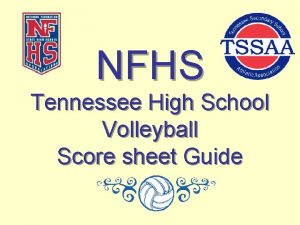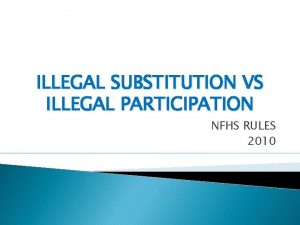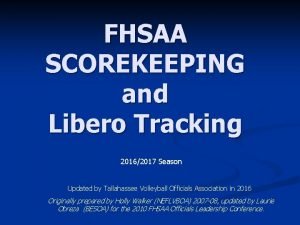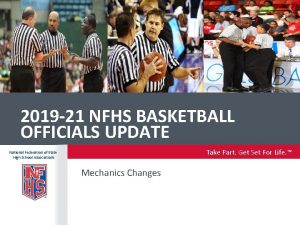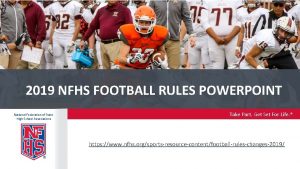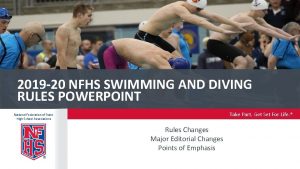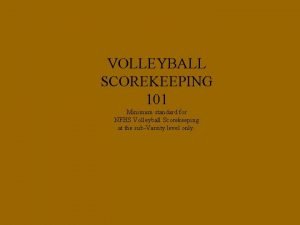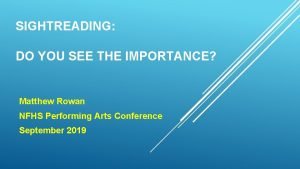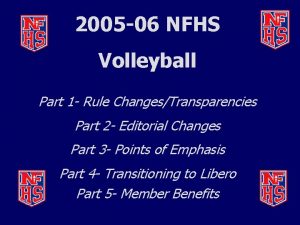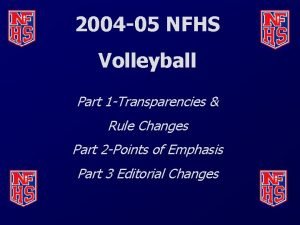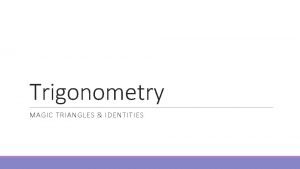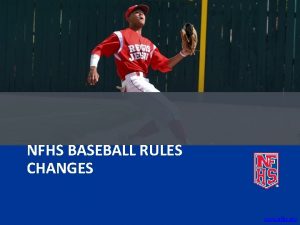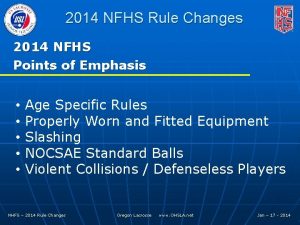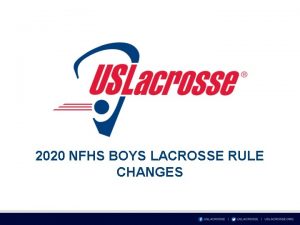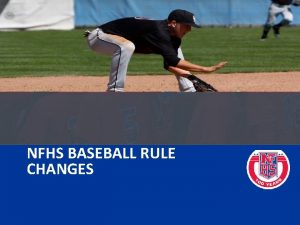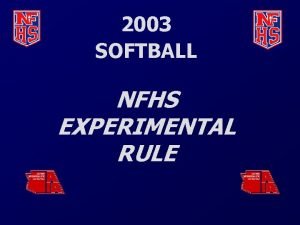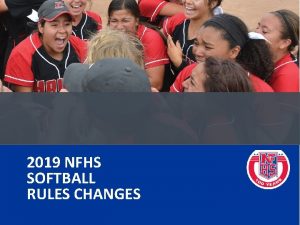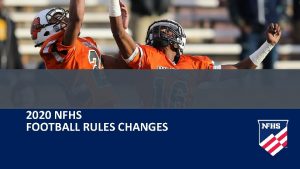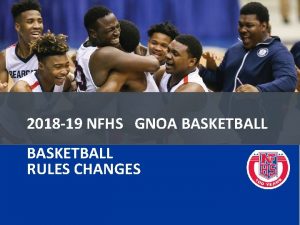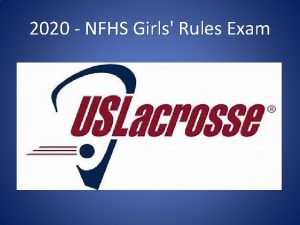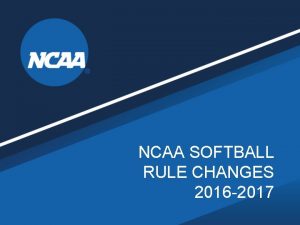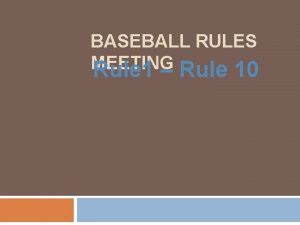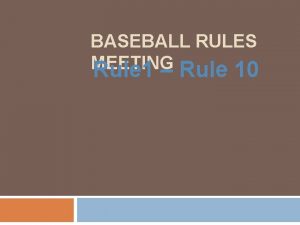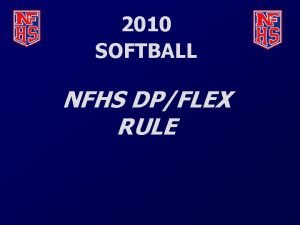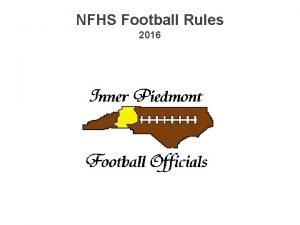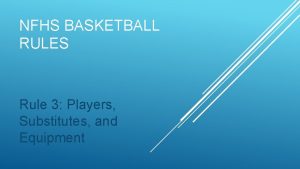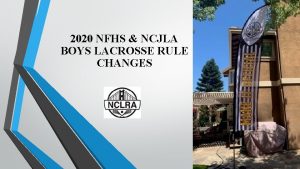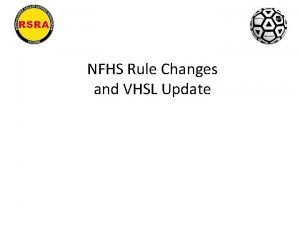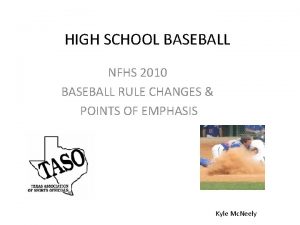2017 18 RULES CHANGES www nfhs org Rule











































- Slides: 43

2017 -18 RULES CHANGES www. nfhs. org

Rule Change RULE 1 -13 -2 COACHING BOX § The coaching box shall be outlined outside the side of the court on which the scorer's and timer's table and team benches are located. The area shall be bounded by a line drawn 28 feet from the end line towards the Division line. At this point a line drawn from the sideline toward the team bench becomes the end of the coaching box going towards the end line. § Note: State Associations may alter the length and placement of the 28 foot (maximum) coaching box. It may not be longer than 28 feet nor extended beyond the end line of the court. § Effective Immediately. Tape may be used to extend the 14 -foot line to 28 feet. www. nfhs. org

Rule Change RULE 1 -13 -2 TEAM BENCH LOCATIONS, COACHING BOX, TIME-OUT AREA § State associations have the ability to alter the location and length of the coaching box. The maximum length of the coaching box cannot exceed 28 feet. In Mechani. Gram A, the traditional end line to 28 foot mark coaching box is used and legal. In Mechani. Gram B, the 14 foot coaching box is placed from 28 -foot mark and back toward the end line (as done in recent years) and is legal. In Mechani. Gram C, the 14 -foot coaching box is relocated to be centered around the 28 foot mark and would be illegal (the 28 -foot mark is furthest to the table). www. nfhs. org

Rule Change RULE 2 -9 -1 SIGNAL TO THE SCORER § When a foul occurs, an official shall signal the timer to stop the clock. The official shall verbally inform the offender, then with finger(s) of two hands, indicate to the scorer the number of the offender and the number of free throws. § Rationale: To minimize foul reporting errors, that occur between the officials and the scorekeepers when the information gets lost in the translation. Two handed reporting is easier for the scorekeepers to see and comprehend in addition to being less confusing. www. nfhs. org

Rule Change RULE 2 -9 -1 SIGNALS (TWO-HAND REPORTING) § Officials should report fouls to the scorer by using two hands to display the fouler’s number. The official’s right hand will indicate the first digit (tens or “two” in the Play. Pic example) and the left hand will show a second digit (ones or “four”), so it appears in a left-to-right sequence to the scorer. When reporting, the official should verbalize 24, not two-four. www. nfhs. org

Rule Change RULE 2 -9 -1 SIGNALS (TWO-HAND REPORTING) § The Official will move to the designated reporting area on the floor. § Make sure that you have the attention of the scorer prior to giving the numbers. § Indicate the color of the Jersey for the player who fouled. § The Official shall report fouls to the scorer by using two hands to display the jersey number of the person who committed the foul. www. nfhs. org

Rule Change RULE 2 -9 -1 SIGNALS (TWO-HAND REPORTING) § The official's right hand will indicate the first digit of the number or the tens and the left hand will indicate the second digit of the number or the ones. § The official shall extend the arms shoulder high towards the table to display the numbers. § The digits of the number should be displayed at the same time. § When reporting, the official shall verbalize the number as twenty-four not two-four. § The scorer will view the number in a left-to-right sequence. www. nfhs. org

Rule Change RULE 2 -9 -1 SIGNALS (TWO-HAND REPORTING) § Indicate the type of foul using the proper signal. § If one, two or three free throws are to be attempted, indicate the number of free throws by using one hand. § If the team is in the bonus for the seventh, eight or ninth foul, indicate the bonus situation raising both hands and display a raised index finger on each hand. § If the foul is a team control foul, after the official signals the specific type of foul, the official will turn and signal such with hand behind their head indicating no free throws will be attempted. www. nfhs. org

Rule Change RULE 2 -9 -1 SIGNALS (TWO-HAND REPORTING) § After reporting and if no free throws are to be attempted, the official will turn from the table and indicate throw-in spot to resume play. www. nfhs. org

Rule Change RULE 3 -4 -1 D TEAM JERSEY § There are no color/design restrictions in the area of the team jersey from the imaginary line at the base of the neckline to the top of the shoulder and in the corresponding area on the back of the jersey. There are restrictions on what identifying names may be placed in this area (see Article 3 -4 -4). § Rationale: Provide guidance on the forthcoming restrictions for this area of the jersey. www. nfhs. org

Rule Change RULES 3 -4 -4 UNIFORMS Identifying name(s) shall adhere to the following: §a. If used, lettering with school name, school’s nickname, school logo, player’s name and /or abbreviation of the official school name shall be placed horizontally on the jersey. §b. The panel in the shoulder area of the jersey on the back may be used for placing an identifying name as well. §Rationale: Provide guidance to persons purchasing uniforms in determining what wording should go onto the jersey. www. nfhs. org

Rule Change RULE 3 -4 -4 A UNIFORMS § If used, lettering is permitted in the form of a school’s name, a school’s nickname, a player’s name or an abbreviation of the school’s official name. Play. Pics A, B and C are all legal examples. www. nfhs. org

Rule Change RULE 3 -4 -4 B UNIFORMS § In Play. Pic A, the shoulder area is identified and a similar area on the back is a legal area for the allowable identifying name. § The initials of a player are shown which is an illegal example. The names are generally placed above the number or in the upper shoulder area on the back of the jersey. § In Play. Pic B, a school logo would be allowed. www. nfhs. org

Rule Change RULE 4 -48 NEW BEHAVIORAL WARNING § Warning for Coach/Team Conduct § A warning to a coach/team for misconduct is an administrative procedure by an official, which is recorded in the scorebook by the scorer and reported to the Head Coach: § Art. 1. . . For conduct, such as that described in rule 10 -5 -1 a, b, d, e, f; 10 -5 -2; 10 -5 -4 the official shall warn the head coach unless the offense is judged to be major, in which case a technical foul shall be assessed. Note: A warning is not required prior to calling a technical foul. www. nfhs. org

Rule Change RULE 4 -48 NEW BEHAVIORAL WARNING § Art. 2. . . For the first violation of rule 10 -6 -1, the official shall warn the head coach unless the offense is judged to be major, in which case a technical foul shall be assessed. Note: A warning is not required prior to calling a technical foul. § Rationale: Stopping play and making sure that the bench and the coach know that an official warning has been given, sends a clear message to everyone in the gym and impacts the behavior of the coach, and in some cases the behavior of the opposing coach. This change in behavior creates a better atmosphere and many times avoids the need to administer a technical foul. www. nfhs. org

Rule Change RULE 4 -48 NEW BEHAVIORAL WARNING §Note: A warning is not required prior to calling a technical foul. www. nfhs. org

Rule Change RULE 4 -48 -1 A NEW BEHAVIORAL WARNING § In Play. Pic A, the official shall stop the game and begin the administrative process to have the warning recorded by the scorer in the scorebook and then notify the head coach. § When the behavior is major NO WARNING should be issued and the officials should rule a technical foul. www. nfhs. org

2017 -18 EDITORIAL CHANGES www. nfhs. org

Editorial Change RULE 4 -4 -7 B BALL LOCATION, AT DISPOSAL § A ball is at the disposal of the thrower or free thrower after it is bounced to him/her. § Rationale: Clarifies what player has the ball at his/her disposal. § NOTE: If the player/FT shooter muffs the bounce, use common sense and re issue the ball, DO NOT call a violation! www. nfhs. org

Editorial Change RULE 4 -4 -7 B BALL LOCATION, AT DISPOSAL § In Play. Pic A, the ball is at the thrower’s disposal when the thrower catches the ball from the official’s bounce. In Play. Pic B, the ball is at the free-thrower’s disposal when the free thrower catches the ball from the official’s bounce. www. nfhs. org

2017 -18 POINTS OF EMPHASIS www. nfhs. org

Points of Emphasis EQUIPMENT WORN ON HEAD FOR MEDICAL OR RELIGIOUS REASON § Specific procedures have been established for allowing a head covering to be worn for medical or religious reasons. A player who is required to wear a head covering for medical or religious reasons must provide a physician statement or appropriate documented evidence to the state association for approval. If approved, the state association shall provide written authorization to the school to be made available to officials. No documentation is required by OHSAA. www. nfhs. org

Points of Emphasis HEAD COVERING WORN FOR MEDICAL AND RELIGIOUS REASONS § In Play. Pic A, the player presents a doctor’s note which indicates the player must wear a head covering for a medical reason, the officials shall permit a non-dangerous covering or wrap to be worn. Not required for the soccer straps that many are wearing. Other types of medical coverings would need OHSAA approval. www. nfhs. org

Points of Emphasis HEAD COVERING WORN FOR MEDICAL AND RELIGIOUS REASONS § In Play. Pic B, the player advises the coach that she/he must wear a head covering for religious reasons, the officials shall permit a non-dangerous covering or wrap to be worn. § The coach and athletic administration must follow the process deemed appropriate by the state. No documentation necessary in Ohio. www. nfhs. org

Points of Emphasis REMINDER: DAITH EAR PIERCING § Daith ear piercings are legal without documentation from the OHSAA § They are an unconventional method of migraine relief www. nfhs. org

Points of Emphasis TEAM CONTROL, THROW-IN § The relevance of team control during a throw-in only applies when a member of the throw- in team fouls. Such fouls shall be ruled team control fouls. Team control during a throw-in is NOT intended to be the same as player control/team control inbounds. Team control inbounds is established when a player from either team who has inbound status gains control of the ball. During the throw-in, 10 -seconds, 3 -seconds, frontcourt status, backcourt status, closely guarded, etc. , are NOT factors as there has yet to be player control/team control obtained inbounds. www. nfhs. org

Points of Emphasis TEAM CONTROL, THROW-IN § With specific regard to the backcourt violation; a team may not be the last to touch a live ball in the front court and then be the first to touch a live ball in the backcourt, provided that team has establish player control/team control on the playing court (either in the backcourt or frontcourt). BY RULE EXCEPTION, during a throw-in a team may leave the front court, establish player control/team control while airborne and land in the backcourt. This is a legal play and ONLY applies to the first player of the offense who touches the ball PRIOR to the end of the throw-in. www. nfhs. org

Points of Emphasis TEAM CONTROL, THROW-IN § When team A fouls during a throw-in (as shown in Mechani. Gram A), a teamcontrol foul occurs and no free throws result. When the throw-in ends the throw-in exception ends for the throw-in team to land anywhere on the playing court. In the two-part Play. Pic sequence, B 2 deflects the throw-in pass and ends the throw-in then A 12 establishes player and team control in team A’s frontcourt when catching the ball in the air after last having been in contact with the court in the frontcourt (Play. Pic A). Once A 12 lands in the backcourt a backcourt violation occurs (Play. Pic B). www. nfhs. org

Points of Emphasis TEAM CONTROL, THROW-IN § In the two-part sequence, the ball is inbounded directly from a throw-in. Since throw-in is untouched the throw-in exception for the pass to be caught by a player inbounds (Play. Pic A) – even with jumping from the frontcourt – and landing anywhere is in effect. A 12’s catch is therefore legal and not a backcourt violation when catching in the backcourt (Play. Pic B). A 12 could even land with one foot down first in the frontcourt and then one foot in the backcourt, provided it is deemed a normal landing. www. nfhs. org

Points of Emphasis TEAM CONTROL, THROW-IN § In Play. Pic A, A 4’s throw-in pass is fumbled by A 10’s fumble does not give Team A the required player- and team-control status inbounds in order to have a backcourt violation. Therefore, any Team A player may legally recover the ball if the ball goes into the backcourt. www. nfhs. org

Points of Emphasis INTENTIONAL FOULS The committee is concerned about the lack of enforcement for intentional fouls during any part of the game but especially at the end of a game. The intentional foul rule has evolved into misapplication and personal interpretations. An intentional foul is a personal or technical foul that may or may not be premeditated and is not based solely on the severity of the act, it is contact that: A swinging elbow with contact in the head/neck area is ALWAYS an intentional foul, WITHOUT exception!! www. nfhs. org

Points of Emphasis INTENTIONAL FOULS § Neutralizes an opponent’s obvious advantageous position. § Contact on an opponent who is clearly not in the play. § May be excessive contact. § Contact that is not necessarily premeditated or based solely on the severity of the act. § A swinging elbow with contact in the head/neck area is ALWAYS an intentional foul, WITHOUT exception!! www. nfhs. org

Points of Emphasis INTENTIONAL FOULS This type of foul may be strategic to stop the clock or create a situation that may be tactically done for the team taking action. This foul may be innocent in severity, but without any playing of the ball, it becomes an intentional act such as a player wrapping their arms around an opponent. The act may be excessive in its intensity and force of the action. These actions are all intentional fouls and are to be called as such. A swinging elbow with contact in the head/neck area is ALWAYS an intentional foul, WITHOUT exception!! www. nfhs. org

Points of Emphasis INTENTIONAL FOULS Officials must be aware of the game situations as the probability of fouling late in the game is an accepted coaching strategy and is utilized by many coaches in some form. Officials must have the courage to enforce the intentional foul rule properly. A swinging elbow with contact in the head/neck area is ALWAYS an intentional foul, WITHOUT exception!! www. nfhs. org

Points of Emphasis INTENTIONAL FOULS § Intentional fouls should be ruled at any point in the game when contact neutralizes an opponent’s advantageous position, contact is not a clear attempt to play the ball or when contact is excessive. An intentional foul is not solely judged on the severity of the act. A swinging elbow. . . . www. nfhs. org

Points of Emphasis GUARDING The addition of rule 10. 7. 12, has been successful in its intent to clean up illegal contact on the ballhandler/dribbler and post players. Players are attempting to replace this illegal contact with contact observed as “body bumping”. Illegal contact with the body must be ruled a foul however, officials must accurately identify if the defense or offense causes the contact and penalize the player causing the illegal contact. www. nfhs. org

Points of Emphasis GUARDING Once a defensive player obtains legal guarding position by facing an opponent with both feet of the floor inbounds, he/she may move to maintain that position in any direction except toward the offensive player being guarded when contact occurs. The defense is not required to keep both feet on the playing court and may jump vertically or laterally to maintain the legal position. If contact occurs prior to the offensive player getting head and shoulders passed the defender the responsibility is on the offensive player. www. nfhs. org

Points of Emphasis GUARDING § A player may not displace an opponent with any body part, including the lower body/legs (as shown in Play. Pic A). In order to gain legal guarding position a player must have two feet down on the court and be facing their opponent. Once a legal guarding position is obtained the defender can maintain that position legally by moving in any direction (backward or laterally) as long as they do not initiate contact into the opponent (as shown in Mechani. Gram B). www. nfhs. org

NFHS OFFICIALS ASSOCIATION CENTRAL HUB WWW. NFHS. ARBITERSPORTS. COM Contains • Sport information • Rules library • Searchable rules book and case book • Video content on officiating sport, competition situations and interpretations

NFHS OFFICIALS ASSOCIATION CENTRAL HUB WWW. NFHS. ARBITERSPORTS. COM

OFFICIAL’S EDUCATION § ZOOM-will be utilized throughout the season to present interesting plays, mechanics and interpretations. § Correction in 2017 -19 Official’s Manual, pg 30, #38 and #39 are reversed. § You are encouraged to visit, http: //www. ohsaa. org/Portals/0/Officiating/3 -personmechanic-handout. pdf? ver=2017 -10 -02 -173219 -060 for an excellent handout that covers all the basic mechanics courtesy of Jim Berry. This would be a very useful pregame tool. www. nfhs. org

www. nfhs. org THANK YOU!

YOU HAVE COMPLETED THE ONLINE RULES MEETING This final screen serves as your completion verification—you may take a screenshot of this screen, if you wish, to keep for your records, as there is no certificate/email of completion. We are aware there is a “Next” button below that is available to click on— please know that this is the final slide, and you cannot go further in the presentation, even though it appears that you can. Your credit may take up to one week to appear on my. OHSAA. Please check your my. OHSAA profile for attendance confirmation.
 Nfhs football rule changes 2020
Nfhs football rule changes 2020 Nfhs wrestling rule changes
Nfhs wrestling rule changes Look back rule softball
Look back rule softball Unnecessary roughness wrestling
Unnecessary roughness wrestling Obstruction rule in softball
Obstruction rule in softball Nfhs track and field rule book
Nfhs track and field rule book Inadvertant whistle
Inadvertant whistle Nfhs spirit rules book
Nfhs spirit rules book Nfhs basketball jersey rules
Nfhs basketball jersey rules What is illegal batting in football
What is illegal batting in football 2020-21 nfhs basketball rules book
2020-21 nfhs basketball rules book Nfhs volleyball uniform rules 2020-2021
Nfhs volleyball uniform rules 2020-2021 Nfhs softball rules
Nfhs softball rules Nfhs swimming and diving rules book
Nfhs swimming and diving rules book Volleyball
Volleyball Windup position
Windup position Nfhs basketball uniform rules
Nfhs basketball uniform rules Changes in latitudes, changes in attitudes meaning
Changes in latitudes, changes in attitudes meaning Example of physical change
Example of physical change 2017 nec code changes
2017 nec code changes Irmer 2017 changes
Irmer 2017 changes Financial rules 2017
Financial rules 2017 3 man umpire mechanics
3 man umpire mechanics Nfhs volleyball scoring
Nfhs volleyball scoring Nfhs volleyball score sheet pdf
Nfhs volleyball score sheet pdf Nfhs javelin sector diagram
Nfhs javelin sector diagram 2019 nfhs baseball exam
2019 nfhs baseball exam Nfhs track and field dimensions
Nfhs track and field dimensions Nfhs artificial noisemakers
Nfhs artificial noisemakers Nfhs
Nfhs Nfhs holding penalty enforcement
Nfhs holding penalty enforcement Ihsaa volleyball lineup sheet
Ihsaa volleyball lineup sheet Nfhs illegal substitution football
Nfhs illegal substitution football Fhsaa volleyball libero tracking sheet
Fhsaa volleyball libero tracking sheet Nfhs basketball officials manual
Nfhs basketball officials manual Nfhs 8-10-2, 8-10-3
Nfhs 8-10-2, 8-10-3 Illegal
Illegal Nfhs diving dd table
Nfhs diving dd table Nfhs volleyball scorebook
Nfhs volleyball scorebook Matt rowan nfhs
Matt rowan nfhs Nfhs volleyball signals
Nfhs volleyball signals Nfhs volleyball signals
Nfhs volleyball signals Triangle trig
Triangle trig Sine rule and cosine rule formula
Sine rule and cosine rule formula
